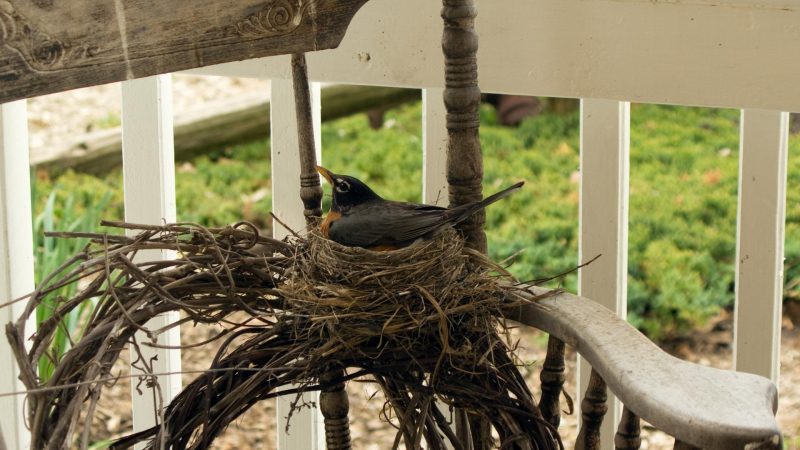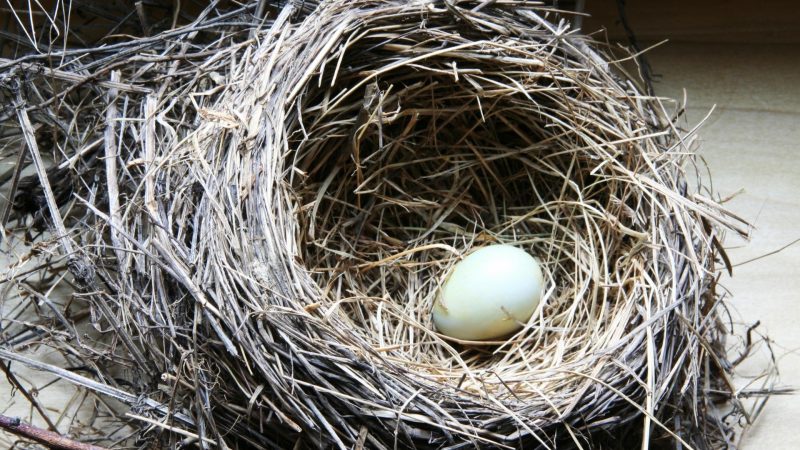Birds are beautiful to watch. However, this will be a different story if they nest on your porch, as they can cause significant damage to your property.
So, how do you keep birds from nesting on the porch? You can keep the birds from nesting by scaring them away. This involves various products designed to frighten birds, such as plastic hawks, reflective bird diverters, or installing a wire mesh and a screen door.
It’s essential to take action early to prevent porch discoloration and foul odors due to birds’ droppings. Moreover, since most birds are protected by federal law, knowing which birds build nests on the porch helps determine if you can or can’t remove their nests. Read on to learn more.
What Bird Builds a Nest on The Porch?

Several birds build their nest on the porch, but the most frequent are the following:
- Pigeons
- Sparrows
- Black-billed magpie
Can You Identify a Bird by Its Nest?

It’s possible to identify a bird through its nest with the help of the following:
Nest Location
The nest location gives a hint of the bird’s identity. Look if the nest is in a cavity nest or cup nest. Birds, such as house sparrow and eastern bluebird den on cavity nest, while American robbins and hummingbirds live on a cup nest.
For instance, Carolina wrens (Thryothorus ludovicianus) are known to nest in unusual places. They like nesting in the hanging basket of flowers located on the porch, as well as the eastern phoebe bird.
Size of the Nest
Another bird’s determinant is the size of the nest. Each nest varies in size, depending on the species of the birds.
In general, larger birds naturally have large nests. However, this can hardly help as some small birds who brood 5 to 6 eggs also build larger nests to cater to all the hatchlings.
Kindly refer to the table below for bird species and the respective size of their nest.
| Bird Species | Hole Size (Entrance) | Height (Entrance) | Mounting Height |
| Bluebird | 3.8 cm | 15 cm | 1-2 m |
| House Sparrow | 4.5 cm | 15 cm | 3-5 m |
| Chickadee | 3.2 cm | 15 cm | 2.5 m |
| Wren | 3.2 cm | 10 cm | 2-3 m |
| Woodpecker | 3.2 cm | 18 cm | 3-6 m |
| Tree Swallow | 3.8 cm | 10 cm | 2-3 m |
| Flicker | 6.35 cm | 10 cm | 2-3 m |
| House Finch | 5.1 cm | 10 cm | 2-3 m |
| Kestrel | 7.6 cm | 23 cm | 3-6 m |
The Shape of the Nest
Each bird species has its own uniquely crafted nest that gives a clue of what species they’re from. Some build simple shallow scrapes, while others make cups.
Some birds also build intricate cave-like structures or hanging pouches. Aside from the structure type, make sure to include the wideness and depth of the nest to ensure the right bird identification.
So, here are the different types of nests, the birds that live in them, and the description of each nest:
Cavity Nests
Cavity nests are usually found in trees, cacti, and snags. Cavity-nesting bird species can also be nestled in house gaps and telephone pole holes, and birdhouses.
The interior of the cavity could be composed of various materials, and some birds may even make loose cups within the hole. Some birds that nest on cavities are:
- House sparrow
- Eastern bluebird
- Chickadees
- Various parrots species
- Woodpeckers
Cup Nests
Cup nests are the most common nests. They’re often located on tree limbs and tree forks or in ledges and other unique places.
These nests typically have different sizes, dimensions, and depths. Furthermore, some birds may create unique inner and outer cup layers in various unusual places.
Birds that live in cup nests are:
- American robins
- Yellow warblers
- Hummingbirds
- Barn swallows
- Various passerines species
Nesting Burrow
This type of nest is dug into the ground with a long tunnel heading to the nesting chamber. These nests are often made of soft material, such as guano collection and loose dirt banks.
The nests within could either be lined with other materials or could be bare. Some birds often dig their own burrows, while others usurp the burrows of other animals.
The birds that live in this type of nest are:
- Burrowing owl
- Barbets
- Kiwis
- Various kingfishers birds
- Great hornbill
- Atlantic puffin
Mound
A mound is a type of nest built on the ground. It comprises large nesting material accumulation in a bell-shaped or tall cone structure.
The bird species that live in the mound are:
- Adelie penguin
- Malleefowl
- Most flamingo bird species
- Horned coot
Scrape Nest
Scrape nests are shallow nests found on the ground with lesser nesting materials. These nests possess a light lining of weeds, grass, pebbles, and other natural debris.
This type of nest is famous among terrestrial birds and are typically used by:
- Killdeer
- Arctic tern
- Common ostrich
- American avocet
- Various shorebird species
Nest Materials
Another pointer that helps you determine the bird species is the nesting materials. Birds use a wide range of materials for their nests, but particular species do prefer specific materials.
For instance, kiwis and kingfishers prefer soft materials like guano accumulation. Meanwhile, other bird species opt for various materials, such as snakeskin, lichen, trash, and more.
Related: How to Get Rid of Barn Swallows? | 8 Prevention Tips
Should I Let Birds Build a Nest on My Porch?

If there’s already an existing nest on your porch, you should wait until the nesting season is over. This way, you wouldn’t be going against the law that protects birds, their eggs, and their nests.
So, whenever you find an active nest on your porch, it’s best to let them be until the nesting season is finally over.
What Home Remedy Keeps Birds Away?

Although birds are beautiful creatures, they can cause significant damage to your structure once they nest on your property. Thus, it’s essential to keep them away from your home as much as possible.
To do this, you may consider using the given home remedies to solve your bird problems:
Remove the Things That Attract Birds on Your Property
One of the reasons birds choose to nest in your place is because they find it attractive. It could be that they find your property rich in food and shelter.
So, it’s best to remove or drain water features to stop encouraging birds from nesting in your area. Furthermore, it’s also ideal to prune your trees to eliminate the shelter birds frequently seek.
Use Bird Deterring Materials
Another way of keeping birds away from your place is by using bird deterring materials, such as:
- Colorful garden balls hung in your trees and gardens will look like eyes in a bird’s perspective and will avoid it as much as possible.
- Reflective objects such as CDs, foil pans, and reflective tape are some of the things you can use to deter birds from coming to your place. These objects can be confusing for birds when they reflect lights.
- You may also use predator toys, such as scarecrows, coyotes, snakes, and owls to scare birds away. Make sure to move these toys for the birds not to get accustomed to the predator figures.
- Bird spikes are also great deterrents of birds. These are long, needle-like rods typically used for bird control. This can be made by hammering nails into wood or plastic cans attached with wire to overhangs and window sills.
Use Baking Soda
Baking soda is one of the natural ways in deterring birds from your place. Just sprinkle baking soda in your yard, and these birds will dislike it upon landing in your place.
Chili Pepper Mixture
To use this solution:
Step 1: Mix 25 to 30 chilies to half-gallon water with one-quarter cup of vinegar.
Step 2: Heat the mixture in a pot or put it under the sun.
Step 3: Let it cool and put it in a clean spray bottle.
Step 4: Spray the mixture to the areas where birds are frequent. Reapply it after some days or after the rain.
Bird Netting
You can also put some bird netting on your porch to effectively keep birds away.
What Scent Do Birds Hate?
Birds hate the scents of essential oils, such as lavender, tea tree oil, and peppermint oil. In addition, they also despise the aroma of cayenne pepper and professional products, such as .
How Do You Keep Birds From Nesting in Unwanted Areas?
To keep the birds from nesting in unwanted areas, make sure to do the following:
- Install wire mesh in the unwanted areas.
- Place the bird feeder away from your home.
- Remove materials that birds can use to build their nest.
- Install predator figures such as cats, owls, snakes, and more.
- Hung reflective objects like CDs, tin foils, and others to trees and gardens.
Related: How to Get Rid of Canada Geese in Your Yard? | 14 Affordable Solutions
How to Get Rid of Birds’ Nests on the Porch?
If you’ve decided to get rid of a bird’s nest on your porch, make sure that it’s inactive first. As you might already know, it’s against the law to remove an active nest.
So, before taking any action, make sure to inspect if the nest still has some eggs. If it doesn’t, you can spray it with an antibacterial spray and let it dry.
Once dried, you can start removing the nest and dispose of it properly in a sealed container or a trash bag. Make sure to put the garbage away from your home.
If you’re unsure of removing the bird’s nest due to legalities, you may call on a licensed wildlife exclusion company. They’ll help you identify the species you have and remove the nest for you.
Using Visual Deterrents
Visual deterrents are an effective, non-lethal method of deterring birds from coming to your place. This will give birds the impression that your property isn’t safe for them.
One of its example is the Flasher . The ‘flasher’ is a wind-powered bird deterrent that’s best hung on the exterior corners of any structure. This comes with a wire arm for installation.
Using Auditory Deterrents
Choosing auditory deterrents is one of the best options to keep the birds away from your property. Some examples of these products are:
Bird B Gone Bird Super Sonic Deterrent
This contains pre-recorded predator/distress calls that keep birds away from your place.
Bird-X BirdXPeller Pro Electronic Bird Repeller
This bird deterrent product contains recorded predator cries that frighten the birds. In addition, the digital sound serves as a warning to the birds to keep away. So, this is one of the ideal items to use against birds.
Tactile Repellents
Tactile repellents use sticking substances that prevent birds from landing. This can be applied to ledges and other roosting structures as pastes or clay-based seed coatings.
Some examples of these tactile repellents are:
Bird BarrierOptical Gel
This product is an all-natural, safe bird deterrent. Furthermore, it’s also easy to install with no tools required.
All you need to do is clean the site and then apply the product to your chosen area. This product’s effectiveness can last up to 2 to 4 years.
Bird-X Bird Spikes
Bird spikes are one of the most effective products in preventing birds from nesting your place. The thorny image of the spikes deters birds from attempting to land in your place.
- KEEP BIRDS AWAY: Turn any area into a bird-free zone with Bird-X...
- STURDY CONSTRUCTION: Crafted from heavy-duty stainless steel, our...
- SIMPLE INSTALLATION: The ready-to-use bird spikes can be easily...
- VERSATILE APPLICATION: Available in a pack of 10 strips, our...
- PEACEFUL SURROUNDINGS: Keep your space free from pigeons,...
When Can I Knock Down a Bird Nest?
You can only knock down a bird’s nest once you positively confirm the nest is inactive. Furthermore, it’s also best to determine the bird species you have to know if it’s legal to remove it.
However, it’s illegal to disturb nesting birds as they’re under the protection of the Migratory Bird Treaty Act. So, it is preferable to read it before engaging in any activity.
Summary
Although having birds flying around your property is nice to see, this can also cause serious problems once they nest in your place. So, it’s best to do some prevention to avoid the worst scenario.
Make sure to clean your surroundings and install the feed feeder away from your house. It would also help to remove the things that attract birds to your property, such as food, water, and shelter.
However, if you already have an existing bird’s nest, you may use the methods written in this article to solve your problem.
List of Sources
Eastern Phoebe. Texas A&M AgriLife Research.
Kurpinski, M. (2001). Thryothorus ludovicianus. University of Michigan.
Migratory Bird Treaty Act. (2020). U.S. Fish & Wildlife Service.
- How to Get Rid of Turtles | Proven Long-Term Solutions! - August 26, 2023
- How to Get Rid of Kingsnakes | Easy & Humane! - August 26, 2023
- How to Get Rid of Northern Water Snakes | Best Solutions and Preventative Measures! - August 19, 2023

